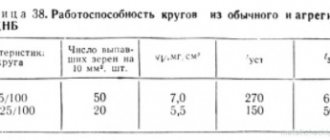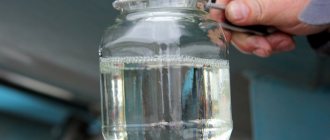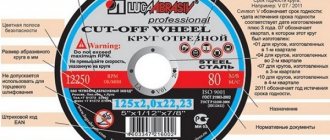07/02/2021 Cutting wheels for metal work, or abrasive discs, are installed on power sawing tools and are used to work with alloy steel, ferrous and non-ferrous metals. Most often, grinders are equipped with cutting wheels for abrasive discs. This useful tool is also known as an angle grinder, but, as a rule, it is used for cutting metal: pipes, angles, sheet products.
Types of cutting wheels
The main criterion used to categorize cutting discs is the type of material they work most effectively with. In accordance with this feature, circles are:
- on metal. Area of use: cutting sheet metal, U-shaped profiles - channels, L-shaped beams - angles, pipes, including profiles, and fittings;
- on wood. Along the perimeter of the outer edge of the circle there are sharp straight, beveled, trapezoidal and other shaped teeth. Discs of this type are also used for cutting MDF panels, plasterboard sheets, double-glazed window elements and pipes made of plastic;
- on stone. They are used for cutting flat and corrugated asbestos-cement sheets, paving stones, stone structures that can withstand heavy loads of paving slabs, as well as objects made of concrete and sand-lime brick (see figure).
Another criterion used to classify cutting discs for angle grinders is their production technology.
Abrasive discs. The structural basis of such a circle is made up of at least 2 layers of the so-called. fiberglass mesh, and a mass including abrasive materials is applied on top of it. These could be:
- electrocorundum This is a super-hard, resistant to chemically aggressive environments and fire-resistant material, which is based on aluminum oxide A2O3;
- silicon carbide. Chemical inorganic binary compound of the elements carbon (C) and silicon (Si);
- corundum. The most common is zirconium corundum (ZrO2+A2O3 alloy). It is characterized by hardness, density and, at the same time, significant viscosity.
The technology for manufacturing discs intended for cutting metal objects involves heat treatment. After passing this stage, the product acquires increased resistance to destructive loads. There are two types of abrasive consumables/materials based on configuration. These are the disks:
- concave (more precisely, their seat sleeve is concave);
- flat.
Diamond discs. Used for cutting objects made from materials characterized by increased strength:
- natural/natural stone;
- asphalt pavement;
- non-slit red brick of grades M300, M250 and M200;
- marble, including artificial;
- fine-grained granite - the most durable of all types of this rock;
- concrete of all common grades - B40, B30, B25, B20, B15, etc.
Made from steel. The end surface of the disk is covered with particles of abrasive mass. They represent diamond chips. The range of variation of the width (S) of the diamond-containing layer is as follows: 1.50 mm ≤S≤ 3.0 mm.
Three types of diamond-containing cutting wheels are supplied to the market:
- segmented. The cutting edge with an abrasive mass applied to it is a collection of individual segments. Using a consumable tool of this type, dry cutting is carried out;
- solid. Structurally, it is made in the form of a monolithic disk with a continuous diamond abrasive edge. Designed for dry cutting;
- Turbo disc. The configuration of its diamond-containing edge resembles a wave with inclined grooves. Their presence reduces the area of contact with the processed material. This design solution ensures that the cooling process occurs naturally. The disk is essentially universal. Used for both types of cutting: dry and with coolant.
Types of attachments for angle grinders
The most common tool for repairs, construction and solving everyday problems is considered to be an angle grinder, which is traditionally called an “grinder”. This tool allows you to carry out a number of different works (cutting, grinding, sharpening, roughing, polishing, stripping, etc.), for which the USHL is equipped with appropriate disks and attachments. The main types of devices are as follows:
- Cutting wheels. They vary depending on the type of material to be worked with (metal, stone, wood, etc.). Cutting discs can be all-metal or made of abrasive material.
- Grinding and polishing. There are sponge, felt, with replaceable sandpaper, conical, etc.
- Sharpening and roughing. Necessary for sharpening tools and cleaning surfaces from various layers.
Bundle type
The type of bond has a direct impact on the quality of the saw, the level of work productivity, as well as the strength of the product. The production of cutting discs is based on the use of two types of bond.
Organic. A ligament of this type is in turn divided into:
- bakelite. To create its base, formaldehyde resins are used - liquid and/or crushed to a powdery consistency - together with fillers: pyrite (this mineral contains iron disulfide (FeS2)), alabaster (calcium diacquasulfate), cryolite (a mineral belonging to the class of natural fluorides ). Cutting wheels created on the basis of a bakelite bond are characterized by increased resistance to external influences working on compression/bending. However, they do not tolerate contact with alkaline coolant very well. The permissible content of such a water-soluble chemically strong base is no more than 1.5%. As for the rotation speed, its value can exceed 80 m/sec. The main disadvantage of the bakelite binder is its low heat resistance. It will become fragile if it heats up to 200°C during operation, and will begin to burn out at 250°C -300°C;
- vulcanite. It is a mass that includes 2 components – sulfur and rubber. Subjected to a heat treatment procedure. The consumable instruments in question made on its basis are characterized by a dense structure without sacrificing elasticity. The strength of the vulcanite bonded blade ensures a cutting speed of up to 80 m/sec.
Inorganic. This bond is ceramic. It consists of the following components:
- feldspar is a mineral belonging to the class of silicates;
- quartz - the main mineral from the group of silicas;
- chalk – a type of limestone (CaCO3);
- liquid glass - an alkaline aqueous solution of potassium silicates K2O(SiO2)n and/or sodium silicates Na2O(SiO2)n. Another common name for this substance is silicate glue;
- talc is a mineral belonging to the class of silicates (Mg3Si4O10(OH)2);
- refractory clay - kaolin, fireclay, annealed until it loses its plasticity properties.
The ceramic bond increases the water resistance of the cutting wheel. And it itself has the following qualities: resistance to contact with chemically aggressive substances and a high level of fire resistance. The disadvantages include: it does not tolerate bending loads well and is sensitive to impulse (impact) impacts.
Diameters of cutting discs
On the shelves of building materials stores there are cutting wheels with different external diameters. For household work, consumables/tools with the following values of this parameter are most in demand:
- 115.0 mm. Used to work with small angle grinders;
- 150.0 mm;125.0 mm. The area of destination is “grinders”, characterized by medium dimensions and not the highest power;
- 180.0 mm; 230 mm. They are used mainly in conjunction with professional electric drive devices.
A standard cutting wheel has an internal diameter of 22.3 mm. But there are products on the market with other values of this indicator, for example, 32.0 mm.
Comparison of consumables from popular manufacturers
| № | Trademark | Bore hole diameter (mm) | Average price (RUB) | Country of Origin |
| 1 | "Bison" | 22,2 | 25 | China |
| 2 | "Luga-Abraziv" | 22, 22,2 | 30 | Russia |
| 3 | Gigant | 22 | 30 | China |
| 4 | Sturm | 22,2 | 32 | China |
| 5 | Stayer | 22 | 36 | China |
| 6 | Fit | 22 | 42 | China |
| 7 | Hitachi | 22,2 | 45 | Russia, "Luga-Abraziv" |
| 8 | Bosch | 22,2 | 85 | EU |
| 9 | Metabo | 22,2 | 90 | EU |
In addition to abrasive metal cutting wheels for grinders, you can find similar products on sale intended for other power tools. These are cutting discs with a diameter of 350÷400 mm for Husqvarna rail cutters and the like, as well as mini-discs Ø32 of the “Dremel” type for mounting on equipment with a cylindrical shank.
Abrasive substance
The quality of the result of the work of wheels intended for cutting, in addition to the grain size, is determined by the configuration, as well as the characteristics of the abrasive substance. Solid silicon carbide particles are more suitable for machining non-ferrous soft alloys and, in general, non-metallic materials. The shape of electrocorundum grains is optimal for cutting carbon steel objects.
One of the important properties of an abrasive is its degree of tolerance to high temperatures. The best heat resistance indicators are inherent in corundum abrasives. The maximum value of their operating temperatures (T) reaches 1900°C. Carbides of the element boron (B) and diamond-containing abrasives are characterized by heat resistance of 700°С ≤Т≤ 800°С. This figure is the lowest among similar substances.
Abrasive material
Wheels for cutting metal are made of silicon carbide (marked with the letter C) and electrocorundum (A). Silicon carbide is a harder material, but inferior to electrocorundum in strength, which is why its use for metal cutting is limited. In addition to the letter designation, the marking contains a number. The larger it is, the higher the quality of the abrasive. Silicon carbide grades: from 52С to 55С – black, 62С-64С – green. Grades of electrocorundum: from 12A to 16A - normal, 22A-25A - white, 32A-35A - chromium, 37A - titanium, 38A (ZA) - zirconium. The cutting ability of zirconium electrocorundum is 10 times higher than normal.
Thickness of cutting discs
It must be said right away that the thickness of cutting wheels is not standardized. The value of this parameter depends on their outer diameter. Below are the most commonly found numbers on the market that display the thickness of the discs (S) with outer diameters:
- 230.0 mm. 1.60 ≤S ≤ 4.0 mm;
- 180.0 mm. 1.0 ≤S ≤ 4.0 mm;
- 150.0 mm. 0.8 ≤S ≤ 3.20 mm;
- 125.0 mm. 0.8 ≤S ≤ 3.20 mm;
- 115.0 mm. 1.0 ≤S≤ 3.20 mm.
It is rational to use discs with a small thickness in conjunction with low-power angle grinders. The lower the value of parameter S, the faster and easier the cutting occurs. The reason for this phenomenon is obvious: the level of resistance of materials is lower. Working with a thick disk will require great physical effort from the performer. The figure shows the layer-by-layer structure of a conventional cutting wheel. Studying it will help you find out which elements combine to ultimately form the thickness of such a product.
Advantages and disadvantages
Like any product produced by modern industry, cutting wheels have their own pros and cons. Let's consider only the main ones.
Abrasive consumables
Among the advantages of disks of this type it is worth highlighting:
- during active use the wheel does not become dull;
- cooling occurs naturally due to the porous structure;
- there is a wide range of product items on the market;
- acceptable price;
The disadvantages of abrasive consumables/tools include:
- wear out quickly;
- cutting is accompanied by the appearance of a characteristic, rather strong odor in the surrounding area;
- During the work, sheaves of bright sparks are formed.
Diamond cutting wheels
Such products have the following advantages:
- minimal formation of sparks during the cutting procedure;
- absence of a strong unpleasant burning smell;
- high wear resistance;
- increased cutting accuracy.
Among the disadvantages of diamond-containing cutting wheels, home craftsmen with extensive experience highlight:
- low level of thermal resistance;
- considerable price.
Selection rules
The choice of consumables/tools should be approached with full responsibility. Otherwise, additional unnecessary costs of time and money may appear. In this regard, it is worth listening to the opinion of professional builders.
Cutting wheel
An ideal blade designed for cutting various objects has the following characteristics:
- made with a reinforcing component based on bakelite binder;
- abrasive substance: for stainless steel structures – white electrocorundum; for objects made of iron or its alloys (these are so-called ferrous metals) - simple electrocorundum;
- cross-sectional size of a circle for cutting metal products in everyday conditions – from 1.60 to 2.0 mm;
- the outer diameter of the disk for cutting metal objects for domestic purposes is 125.0 mm;
- When cutting objects made of steel is intended, the abrasive must be formed from fine particles.
Diamond wheel
Selecting a wheel for diamond cutting should take into account the following expert recommendations:
- for working with structural elements made of non-cellular concrete, brick and granite objects, the most suitable consumable material/tool is a segmented disk, the width of the diamond-containing layer (S) lies within 2.50 ≤ S ≤ 3.0 mm, and the outer diameter of this product – 230 mm;
- if it is necessary to create grooves along which engineering and technical communications will be laid, preference should be given to a segmented circle with dimensions of an outer diameter of 350.0 mm and a diamond-containing layer of 3.50 mm;
- It is recommended to process marble and ceramic tiles using a solid diamond-coated cutting tool. Cutting of these materials must be done with water cooling;
- It is better to cut reinforced concrete structures using a diamond-containing turbo disc.
Cutting wheel for woodworking
The best option for processing wooden products are discs made from hard alloys, reinforced by soldering, containing a large percentage of carbides of the elements cobalt (Co2C) or tungsten (WC), and characterized by:
- thickness 3.2 mm;
- numerical value of the outer diameter size – max 250 mm; min 125 mm;
- number of teeth if necessary: longitudinal cutting - no more than 60. Their ideal slope is 5°-15°; cross cutting - 80-90 pieces with a slope of 15°-20°.
Optimal rotation speed when cutting wood:
- exotic rocks – up to 85 m/sec;
- carpentry purposes – up to 80 m/sec;
- hard rocks – up to 80 m/sec;
- soft rocks – up to 90 m/sec.
Basic designations
A thorough approach to the selection of abrasive wheels depends on the following criteria:
- Overall circle diameter;
- Thickness of the disk plate;
- Bore diameter (rarely differs from 22.2).
In addition, the basic information usually includes an expiration date.
According to standards, the thickness of a plate with a diameter of 125 mm is from 2.3 mm to 2.5 mm. Discs of 1-1.2 mm are considered thin with the same diameter .
The main information should be looked for on the front surface: the specialization of the wheel will be indicated there - whether it is intended for cutting only steel or is also suitable for non-ferrous metals. There are also universal options. The size of the cutting disc, expiration date and the maximum number of revolutions allowed during use are also indicated there.
Best before date
Usually these numbers, stamped around the mounting hole of the plate, are given little significance. However, cutting disc insist on using the product within the time period they specify: for example, V 01/2018 would mean an expiration date before the beginning of the first quarter of 2018.
External diameter
This most important parameter, in fact, means the class of angle grinder for which the cutting wheel is designed. The following options are common: 115, 125, 150, 180 or 230 mm. It is unacceptable to install a wheel of a larger diameter than it should on the grinder. This is expressly prohibited by safety precautions coupled with common sense. Firstly, the protective casing will interfere, and secondly, the rotation speed of the cutting edge will go far beyond the limits provided by the manufacturer of the power tool, which is highly likely to result in serious injuries and failure of the equipment.
Plate thickness
The thinner the cutting disc, the easier it is to cut through the material: the smaller blade area reduces its resistance. In general, thin plates have many advantages:
At the same time, the disadvantage of this kind of circles is no less obvious: rapid grinding. However, for low-power, battery-powered angle grinders that are not intended for long-term operation without interruption, this type of disc is ideal.
It is worth noting that, subject to safety standards and operational requirements for power tools, neither thin nor thick disks are too dangerous: the reinforcing mesh holds the structure of the plate, regardless of its thickness.
Specification parameters
A specification is a four-character code that encrypts information about the fraction of abrasive grain and the substances that bind it. For example, AS is marked with highly purified white electrocorundum, intended for cutting stainless steel workpieces. The code numbers indicate the grit per unit of disk surface: to work with steel, you will need a coarse-grained cutting wheel marked 30 or 24.
For non-ferrous metals you will need a circle with code 40, or even 60 if the metal is soft. Further, the letter of the Latin alphabet indicates the hardness of the binder component. The closer the letter is to the end, the harder the bond. However, there is an inverse relationship with the hardness of the material being processed, since it is not the bond that cuts, but the abrasive grain.
The last two symbols rarely change and indicate the binding component, which uses the viscous thermosetting plastic Bakelite.
Source










